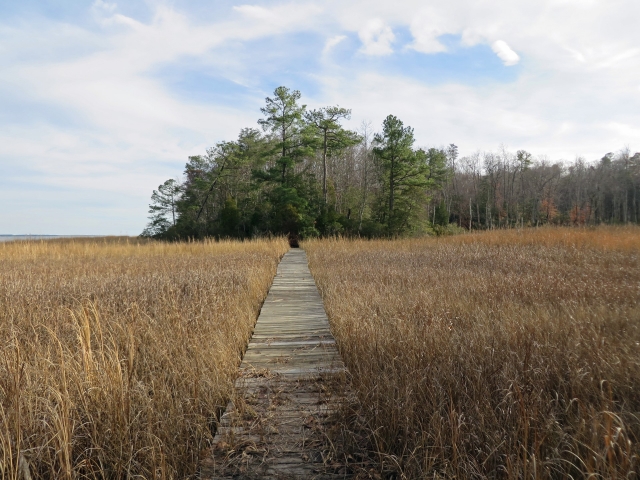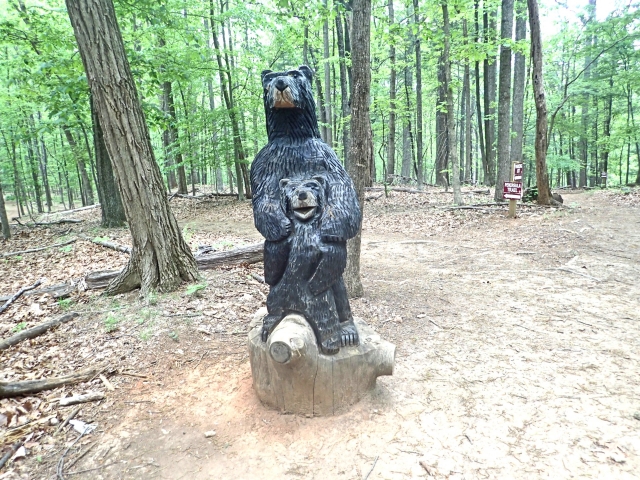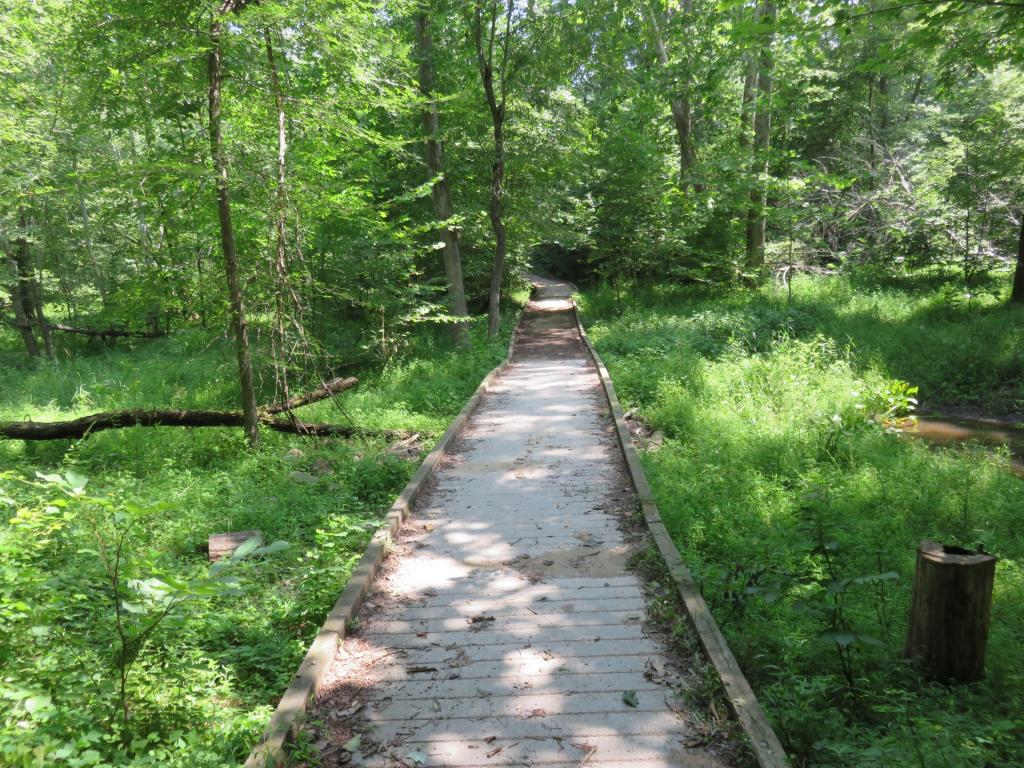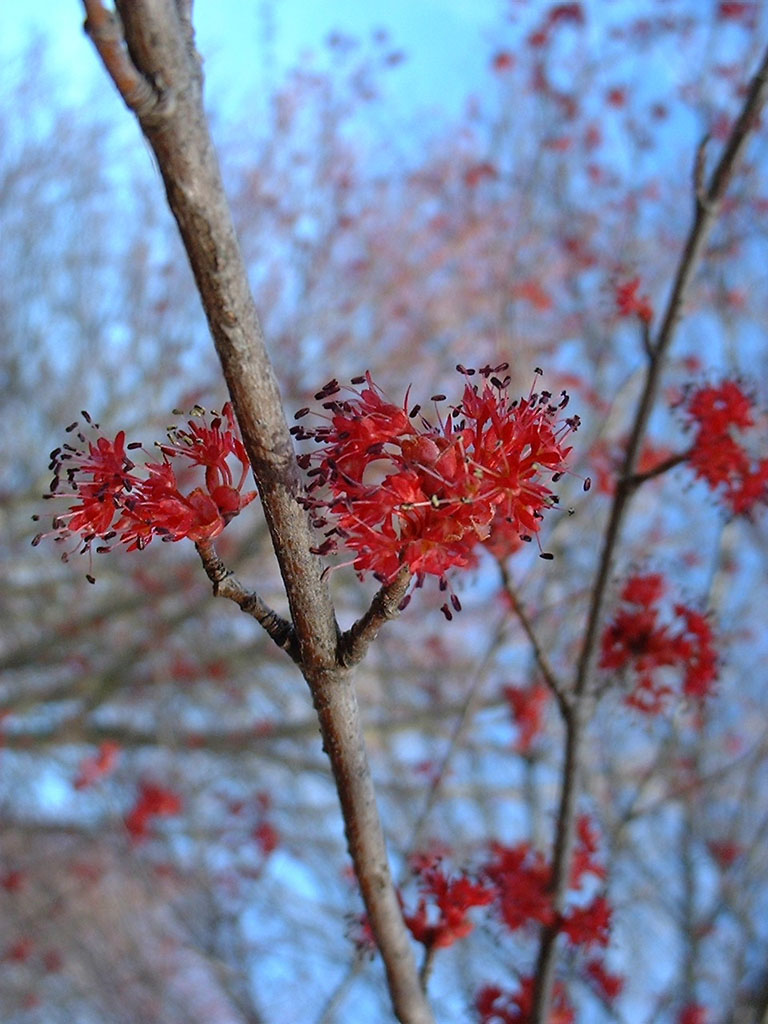Formerly the Timberneck farm, Machiacomoco is one of the newest state parks. Located in the southern part of Gloucester County along the York River, Machicomoco State Park is approximately 10 miles downriver from Werowocomoco. This was a village that served as the headquarters of Chief Powhatan, a Virginia Algonquian political and spiritual leader when the English founded Jamestown in 1607. The landscape of Timberneck was most certainly associated with Powhatan’s extensive Chiefdom.
An open-air interpretive pavilion provides information on the culture, landscape and movement of Virginia Indians through displays and a walking path in the landscape. In addition, a paved trail follows along the main park road for walking or bike riding. The surrounding land provides diverse wildlife habitats, from open fields to woodlands and waterfront/marsh areas supporting deer, turkey, and many species of songbirds and birds of prey. Other amenities include a campground, two picnic shelters, a car-top boat launch pier, and a set of small floating docks on Timberneck creek for daytime boat tie-ups and fishing.
Hiking/Backpacking
Jul 3, 2021 11:12 AM
Distance : 1.2 mi
Duration (Total) : 1h 26m 13s
Duration (Active) : 1h 21m 11s
Duration (Paused) : 5m 2s
Avg Speed : 0.9 mi/h
Total Ascent : 154 ft
Highest Point : 32 ft
Difficulty : Easy
On hot days, be sure to wear sunscreen and bring water.
-Tracked by Riverinemn, on Ramblr
Trip Facts
Parking Location: Main parking for the Interpretive Area
Parking Availability : 100 or so slots
Fee: $5 per car
Hours: 8 AM to Dusk
Verizon INTERNET Coverage: 2 bars
Month Recorded: July
This is a short, easy hike in the Interpretive Area containing the exhibits, consisting primarily of a stroll through open meadows. It has little shade, so try to come on a cool day. Along the way, you will encounter a number of historical signs and exhibits, while also enjoying great views of Timberneck Creek and the York River. As a bonus, you can also drive or walk to the nearby dock area for shorebirds and crabs. If you want to explore more of the park, see the trail map link below.
WEB LINKS - INTERNET CONNECTION REQUIRED and DATA RATES APPLY
Press Highlighted Link - If link not active in your app, copy link to Web browser
**************************************
To learn more about this site, click the link below:
https://www.dcr.virginia.gov/state-parks/machicomoco
For more hikes in the park, see the trail map:
https://www.dcr.virginia.gov/state-parks/document/data/trail-guide-machicomoco.pdf
Parking Location: Main parking for the Interpretive Area
Parking Availability : 100 or so slots
Fee: $5 per car
Hours: 8 AM to Dusk
Verizon INTERNET Coverage: 2 bars
Month Recorded: July
This is a short, easy hike in the Interpretive Area containing the exhibits, consisting primarily of a stroll through open meadows. It has little shade, so try to come on a cool day. Along the way, you will encounter a number of historical signs and exhibits, while also enjoying great views of Timberneck Creek and the York River. As a bonus, you can also drive or walk to the nearby dock area for shorebirds and crabs. If you want to explore more of the park, see the trail map link below.
WEB LINKS - INTERNET CONNECTION REQUIRED and DATA RATES APPLY
Press Highlighted Link - If link not active in your app, copy link to Web browser
**************************************
To learn more about this site, click the link below:
https://www.dcr.virginia.gov/state-parks/machicomoco
For more hikes in the park, see the trail map:
https://www.dcr.virginia.gov/state-parks/document/data/trail-guide-machicomoco.pdf

Trailhead
The trail starts just to the left of the restrooms. Note that the interpretive trail has blazed red posts.
Diamondback Terrapin
We happened to see this terrapin near the restrooms, but it usually inhabits shorelines and marshes.
Common Name: Diamonback Terrapin
Scientific Name: Malaclemys terrapin
The diamondback terrapin is a species of turtle native to the brackish coastal tidal marshes of the eastern and southern United States. It has one of the largest ranges of all turtles in North America, stretching as far south as the Florida Keys and as far north as Cape Cod. The name "terrapin" is derived from the Algonquian word torope. The name originally was used by early European settlers in North America to describe these brackish-water turtles that inhabited neither freshwater habitats nor the sea. The common name refers to the diamond pattern on top of its shell (carapace), but the overall pattern and coloration vary greatly.
Terrapins look much like their freshwater relatives, but are well adapted to the near shore marine environment. They have several adaptations that allow them to survive in varying salinities. They can live in full strength salt water for extended periods, and their skin is largely impermeable to salt. Terrapins also exhibit unusual and sophisticated behavior to obtain fresh water, including drinking the freshwater surface layer that can accumulate on top of salt water during rainfall and raising their heads into the air with mouths open to catch falling rain drops. Terrapins are strong swimmers. They have strongly webbed hind feet, but not flippers as do sea turtles. They have strong jaws for crushing shells of prey, such as clams and snails. This is especially true of females, who have larger and more muscular jaws than males. Terrapins tend to live in the same areas for most or all of their lives, and do not make long distance migrations.
WEB LINKS - INTERNET CONNECTION REQUIRED and DATA RATES APPLY
Press Highlighted Link - If link not active in your app, copy link to Web browser
**************************************
To find out more about this animal, visit this site:
https://en.wikipedia.org/wiki/Diamondback_terrapin
***************************************
COPYRIGHT NOTICES
Text - Encyclopedia of Life,Wikipwdia, Creative Commons Attribution-ShareAlike 3.0
Photo - Encyclopedia of Life,Kelly Creger,cc-by-nc-sa,Unmodified
Common Name: Diamonback Terrapin
Scientific Name: Malaclemys terrapin
The diamondback terrapin is a species of turtle native to the brackish coastal tidal marshes of the eastern and southern United States. It has one of the largest ranges of all turtles in North America, stretching as far south as the Florida Keys and as far north as Cape Cod. The name "terrapin" is derived from the Algonquian word torope. The name originally was used by early European settlers in North America to describe these brackish-water turtles that inhabited neither freshwater habitats nor the sea. The common name refers to the diamond pattern on top of its shell (carapace), but the overall pattern and coloration vary greatly.
Terrapins look much like their freshwater relatives, but are well adapted to the near shore marine environment. They have several adaptations that allow them to survive in varying salinities. They can live in full strength salt water for extended periods, and their skin is largely impermeable to salt. Terrapins also exhibit unusual and sophisticated behavior to obtain fresh water, including drinking the freshwater surface layer that can accumulate on top of salt water during rainfall and raising their heads into the air with mouths open to catch falling rain drops. Terrapins are strong swimmers. They have strongly webbed hind feet, but not flippers as do sea turtles. They have strong jaws for crushing shells of prey, such as clams and snails. This is especially true of females, who have larger and more muscular jaws than males. Terrapins tend to live in the same areas for most or all of their lives, and do not make long distance migrations.
WEB LINKS - INTERNET CONNECTION REQUIRED and DATA RATES APPLY
Press Highlighted Link - If link not active in your app, copy link to Web browser
**************************************
To find out more about this animal, visit this site:
https://en.wikipedia.org/wiki/Diamondback_terrapin
***************************************
COPYRIGHT NOTICES
Text - Encyclopedia of Life,Wikipwdia, Creative Commons Attribution-ShareAlike 3.0
Photo - Encyclopedia of Life,Kelly Creger,cc-by-nc-sa,Unmodified
Eastern Meadowlark
You may see this bird flying through the fields.
Common Name: Eastern Meadowlark
Eastern meadowlarks are medium-sized songbirds, with long, slender, light gray bills and dark brown eyes. Male Eastern Meadowlarks have grayish heads with blackish stripes, a yellow “eyebrow”, and dark crowns with a median stripe. The wings and tail are streaked and barred with dark and light brown. Males have a broad white moustachial stripe and a yellow chin, which is divided from the underparts by a broad black breast band. Females are similar to males except that they are smaller, paler, and have a narrower breast band. The Eastern Meadowlark is a bird of open fields and pastures, meadows, and prairies, and populations in the eastern United States have declined in recent decades as acreage of these habitats has declined. Their diet varies with the season. In the spring they feed mainly on cutworms, grubs, and caterpillars. When summer comes they eat insects, primarily beetles and grasshoppers. These birds sing from fenceposts and telephone lines or stalk through the grasses, probing the ground for insects with their long, sharp bills. On the ground, their brown-and-black dappled upperparts camouflage the birds among dirt clods and dry grasses.
WEB LINKS – INTERNET CONNECTION REQUIRED and DATA RATES APPLY
Press Highlighted Link – If link not active in your app, copy link to Web browser
**************************************
To find out more about this bird, visit the Cornell birding site:
https://www.allaboutbirds.org/guide/Eastern_Meadowlark/id
***************************************
COPYRIGHT NOTICES
Text – Encyclopedia of Life, © The Regents of the University of Michigan and its licensors Source: Animal Diversity Web, Attribution-NonCommercial-ShareAlike 3.0 Unported (CC BY-NC-SA 3.0)
Photo - Encyclopedia of Life, Image of Sturnella magna © Greg Lasley, Attribution-NonCommercial 4.0 International (CC BY-NC 4.0) ,Unmodified
Cornell Lab of Ornithology, All About Birds at http://www.allaboutbirds.org/
Common Name: Eastern Meadowlark
Eastern meadowlarks are medium-sized songbirds, with long, slender, light gray bills and dark brown eyes. Male Eastern Meadowlarks have grayish heads with blackish stripes, a yellow “eyebrow”, and dark crowns with a median stripe. The wings and tail are streaked and barred with dark and light brown. Males have a broad white moustachial stripe and a yellow chin, which is divided from the underparts by a broad black breast band. Females are similar to males except that they are smaller, paler, and have a narrower breast band. The Eastern Meadowlark is a bird of open fields and pastures, meadows, and prairies, and populations in the eastern United States have declined in recent decades as acreage of these habitats has declined. Their diet varies with the season. In the spring they feed mainly on cutworms, grubs, and caterpillars. When summer comes they eat insects, primarily beetles and grasshoppers. These birds sing from fenceposts and telephone lines or stalk through the grasses, probing the ground for insects with their long, sharp bills. On the ground, their brown-and-black dappled upperparts camouflage the birds among dirt clods and dry grasses.
WEB LINKS – INTERNET CONNECTION REQUIRED and DATA RATES APPLY
Press Highlighted Link – If link not active in your app, copy link to Web browser
**************************************
To find out more about this bird, visit the Cornell birding site:
https://www.allaboutbirds.org/guide/Eastern_Meadowlark/id
***************************************
COPYRIGHT NOTICES
Text – Encyclopedia of Life, © The Regents of the University of Michigan and its licensors Source: Animal Diversity Web, Attribution-NonCommercial-ShareAlike 3.0 Unported (CC BY-NC-SA 3.0)
Photo - Encyclopedia of Life, Image of Sturnella magna © Greg Lasley, Attribution-NonCommercial 4.0 International (CC BY-NC 4.0) ,Unmodified
Cornell Lab of Ornithology, All About Birds at http://www.allaboutbirds.org/
Boardwalk
Walk the boardwalk for more views of the York River.
Timberneck House
The Timberneck farmhouse was built for the Catlett family c. 1800, with an addition added around 1850.
Resting Spot
Sit in the shade of a large oak tree and enjoy the views.
End of the Trail
The trail ends at this high viewpoint on a peninsula. Return the way you came.
Grasshopper Sparrow
Common Name: Grasshopper Sparrow
A small (4 ½ inches) sparrow named for its insect-like song, the Grasshopper Sparrow is easy to overlook. Mostly buff-brown streaked with brown above and cream below, this sparrow may be identified from its large head, small body, and pale eye-stripes. Males and females are similar to one another in all seasons, while the juvenile has a streaked breast. Despite its wide distribution, the Grasshopper Sparrow is an uncommon breeder throughout most of its breeding range due to specific habitat requirements. The Grasshopper Sparrow inhabits grassland habitats in its breeding and winter ranges. This species prefers grasslands that are drier and more open, with less ground-covering grass litter, than those inhabited by Henslow’s Sparrow (Ammodramus henslowii). In summer, Grasshopper Sparrows eat insects (coincidentally, grasshoppers make up a significant portion of their diet), while in winter, they primarily eat seeds. Grasshopper Sparrows forage on the ground. Like many grassland-dwelling bird species, the Grasshopper Sparrow is best identified by ear, specifically by listening for its insect-like song. Due to its feeding habits and cryptic coloration, Grasshopper Sparrows are difficult to see while at rest, and may be most easily seen while on short flights above the grass.
WEB LINKS – INTERNET CONNECTION REQUIRED and DATA RATES APPLY
Press Highlighted Link – If link not active in your app, copy link to Web browser
**************************************
To find out more about this bird, visit the Cornell birding site:
https://www.allaboutbirds.org/guide/Grasshopper_Sparrow/id
***************************************
COPYRIGHT NOTICES
Text – Encyclopedia of Life, © Smithsonian Institution Supplier: Robert Costello, Attribution-NonCommercial-ShareAlike 4.0 International (CC BY-NC-SA 4.0)
Photo - Encyclopedia of Life, DSW_1033a © Jerry Oldenettel , Attribution-NonCommercial-ShareAlike 2.0 Generic (CC BY-NC-SA 2.0) ,Unmodified
Cornell Lab of Ornithology, All About Birds at http://www.allaboutbirds.org/
A small (4 ½ inches) sparrow named for its insect-like song, the Grasshopper Sparrow is easy to overlook. Mostly buff-brown streaked with brown above and cream below, this sparrow may be identified from its large head, small body, and pale eye-stripes. Males and females are similar to one another in all seasons, while the juvenile has a streaked breast. Despite its wide distribution, the Grasshopper Sparrow is an uncommon breeder throughout most of its breeding range due to specific habitat requirements. The Grasshopper Sparrow inhabits grassland habitats in its breeding and winter ranges. This species prefers grasslands that are drier and more open, with less ground-covering grass litter, than those inhabited by Henslow’s Sparrow (Ammodramus henslowii). In summer, Grasshopper Sparrows eat insects (coincidentally, grasshoppers make up a significant portion of their diet), while in winter, they primarily eat seeds. Grasshopper Sparrows forage on the ground. Like many grassland-dwelling bird species, the Grasshopper Sparrow is best identified by ear, specifically by listening for its insect-like song. Due to its feeding habits and cryptic coloration, Grasshopper Sparrows are difficult to see while at rest, and may be most easily seen while on short flights above the grass.
WEB LINKS – INTERNET CONNECTION REQUIRED and DATA RATES APPLY
Press Highlighted Link – If link not active in your app, copy link to Web browser
**************************************
To find out more about this bird, visit the Cornell birding site:
https://www.allaboutbirds.org/guide/Grasshopper_Sparrow/id
***************************************
COPYRIGHT NOTICES
Text – Encyclopedia of Life, © Smithsonian Institution Supplier: Robert Costello, Attribution-NonCommercial-ShareAlike 4.0 International (CC BY-NC-SA 4.0)
Photo - Encyclopedia of Life, DSW_1033a © Jerry Oldenettel , Attribution-NonCommercial-ShareAlike 2.0 Generic (CC BY-NC-SA 2.0) ,Unmodified
Cornell Lab of Ornithology, All About Birds at http://www.allaboutbirds.org/
Common Yarrow
Common Name: Common Yarrow
Scientific Name: Achillea millefolium
Blooming Time: Apr-Nov
Yarrow is a perennial herb that can spread both by seed and by means of creeping stems, known as stolons. It occupies many diverse habitats, including sunny pastures, meadows and roadsides with dry soils, stream sides and waste grounds with sandy or salty soils, and damp woodlands with clay soils. The erect stems are woolly and the dense, flattened flower-heads are typically white, but more rarely they may be pink or reddish. The leaves are deeply divided, forming many small lobes; this feature is referred to by the specific Latin name, millefolium, which means 'thousand leaf'. The name of the genus, Achillea is thought to have arisen as it is said that Achilles used this herb to treat the wounds of his soldiers. The whole plant has a strongly aromatic scent. Yarrow was once held in high esteem as a medicinal plant, and has been used to staunch wounds and to ward off illness and bad luck. Conversely it was believed to be one of the Devil's herbs, and was used in divination. It was also said to cause nosebleeds if a leaf was put into the nostril, and the plant was known as 'nosebleed' in some areas. The leaves and flowers have a bitter, astringent and pungent taste; the alternative common name 'old man's pepper' refers to this quality. Native Americans used tea made from western yarrow to relieve ear-, tooth-, and headaches; as an eyewash; to reduce swelling; and as a tonic or stimulant. Yarrow is a source of nectar for many species of flies, wasps and a few bees. Some grasshoppers, aphids, beetles and caterpillars may feed on it.
DO NOT PICK WILDFLOWERS OR ATTEMPT TO TRANSPLANT THEM. Most wildflowers will not survive replanting.
WEB LINKS – INTERNET CONNECTION REQUIRED and DATA RATES APPLY
Press Highlighted Link – If link not active in your app, copy link to Web browser
**************************************
To find out more about this plant, go here:
https://www.wildflower.org/plants/result.php?id_plant=euco10
***************************************
COPYRIGHT NOTICES
Text – Encyclopedia of Life, © Wildscreen Source: ARKive, Attribution-NonCommercial-ShareAlike 3.0 Unported (CC BY-NC-SA 3.0)
Photo – Encyclopedia of Life, Image of Achillea millefolium © Tichomír Dunlop , Attribution-NonCommercial 4.0 International (CC BY-NC 4.0) , Unmodified
Scientific Name: Achillea millefolium
Blooming Time: Apr-Nov
Yarrow is a perennial herb that can spread both by seed and by means of creeping stems, known as stolons. It occupies many diverse habitats, including sunny pastures, meadows and roadsides with dry soils, stream sides and waste grounds with sandy or salty soils, and damp woodlands with clay soils. The erect stems are woolly and the dense, flattened flower-heads are typically white, but more rarely they may be pink or reddish. The leaves are deeply divided, forming many small lobes; this feature is referred to by the specific Latin name, millefolium, which means 'thousand leaf'. The name of the genus, Achillea is thought to have arisen as it is said that Achilles used this herb to treat the wounds of his soldiers. The whole plant has a strongly aromatic scent. Yarrow was once held in high esteem as a medicinal plant, and has been used to staunch wounds and to ward off illness and bad luck. Conversely it was believed to be one of the Devil's herbs, and was used in divination. It was also said to cause nosebleeds if a leaf was put into the nostril, and the plant was known as 'nosebleed' in some areas. The leaves and flowers have a bitter, astringent and pungent taste; the alternative common name 'old man's pepper' refers to this quality. Native Americans used tea made from western yarrow to relieve ear-, tooth-, and headaches; as an eyewash; to reduce swelling; and as a tonic or stimulant. Yarrow is a source of nectar for many species of flies, wasps and a few bees. Some grasshoppers, aphids, beetles and caterpillars may feed on it.
DO NOT PICK WILDFLOWERS OR ATTEMPT TO TRANSPLANT THEM. Most wildflowers will not survive replanting.
WEB LINKS – INTERNET CONNECTION REQUIRED and DATA RATES APPLY
Press Highlighted Link – If link not active in your app, copy link to Web browser
**************************************
To find out more about this plant, go here:
https://www.wildflower.org/plants/result.php?id_plant=euco10
***************************************
COPYRIGHT NOTICES
Text – Encyclopedia of Life, © Wildscreen Source: ARKive, Attribution-NonCommercial-ShareAlike 3.0 Unported (CC BY-NC-SA 3.0)
Photo – Encyclopedia of Life, Image of Achillea millefolium © Tichomír Dunlop , Attribution-NonCommercial 4.0 International (CC BY-NC 4.0) , Unmodified
Click http://rblr.co/0ZAoS to see more details.



















































































































































